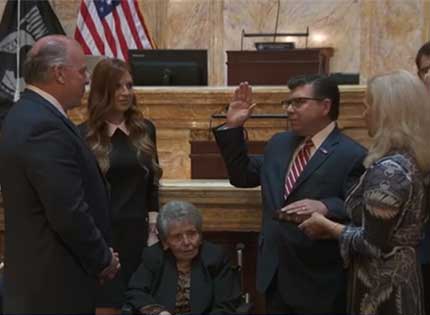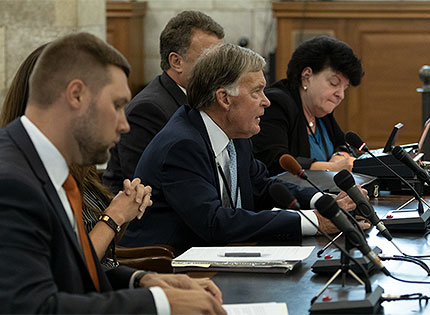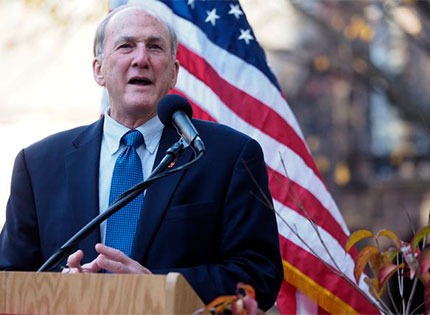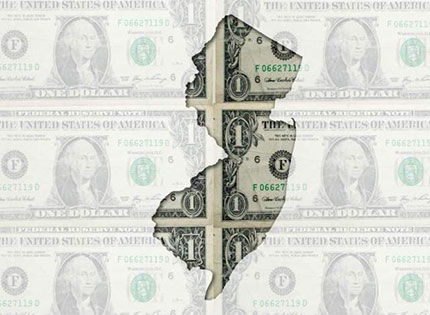
- 2019-10-24
- NJTV News
In a somber ceremony at the State House, New Jersey lawmaker Anthony Bucco took over the state Senate seat his namesake father had held for more than 20 years until his death last month from a heart attack.

- 2019-07-29
- NJ Advance Media for NJ.com
The head of the state’s Economic Development Authority got an earful Monday from lawmakers questioning if an administration critical of New Jersey’s corporate tax incentives was withholding promised tax breaks from businesses.
State Sens. Bob Smith, D-Middlesex, and Declan O’Scanlon, R-Monmouth, said at a Statehouse hearing Monday they have been fielding complaints from New Jersey businesses whose tax credits are past due and are concerned the EDA is not paying out.
“No. 1, is that true? No. 2, how many are we talking about?” Smith asked EDA CEO Tim Sullivan.

- 2019-07-22
- NJ Advance Media for NJ.com
Rutgers University President Robert Barchi is stepping down after this school year and will formally announce his decision at Tuesday’s Board of Governors meeting, he told NJ Advance Media in an exclusive interview Monday.

- 2019-07-22
- Star-Ledger Guest Columnists
New Jersey is home to five military bases, from Joint Base McGuire-Dix-Lakehurst to Picatinny Arsenal, from Naval Weapons Station Earle to the Coast Guard Training Center in Cape May and the 177th Fighter Wing in Atlantic City. These installations are essential to our national security – and our location has made them critical pieces of our nation’s military preparedness.
But, even beyond their importance to national security, our bases are also critical to our state’s economy. Together, our bases employ 70,000 residents both directly and indirectly. Our communities are made stronger by our military families, and local economies are made stronger by them, too.

- 2019-07-09
- NJ Advance Media for NJ.com
The modern port system was created in Newark in April 1956, when a refitted oil tanker carrying fifty-eight trailer-sized steel boxes sailed from Newark to Houston, launching the beginning of container shipping.
Most than 60 years later, parts of the port still look much like it did then. And with a huge increase in the amount of cargo now coming into the marine terminals serving the New Jersey and New York region — as well as the impact of global warming on port operations — billions will be needed to remake the waterfront in the coming decades, officials warn.

- 2019-07-02
- ROI-NJ Op-Ed
In his inauguration address, Gov. Phil Murphy pledged to be the governor of “all 9 million who call our great state home.”
On Sunday, the governor signed the fiscal 2020 state budget while repeatedly asking those in the audience, “Whose side are you on?”
Clearly, by his comments Sunday, the governor has chosen a “side,” which represents only a portion of those 9 million people.
- 2019-06-17
- NJ Advance Media for NJ.com
New Jersey’s quality schools and its access to health care help make it the fifth-best place to raise a child, according to the annual look at family well-being in America.
For 30 years, the Annie E. Casey Foundation has published Kids Count, a compilation of data measuring health, wealth and stability, to draw attention to the needs of struggling kids and families. The goal is to influence politicians and policy makers who can make the changes that could improve thousands of lives.
This year, New Jersey continued its streak of top-10 ratings since at least 2010, placing 5th behind New Hampshire, Massachusetts, Iowa, and Minnesota.

- 2019-06-16
- NJ Advance Media for NJ.com
Democratic lawmakers will introduce their own state budget Monday that ditches Gov. Phil Murphy’s long-sought proposal to raise tax increases on millionaires in New Jersey, setting up a showdown with the progressive Democratic governor in the coming days, NJ Advance Media has learned.

- 2019-05-28
- ROI-NJ Op-Ed
Policymakers, including the Legislature and the Governor’s Office, all agree — tax incentives are an important and effective tool in New Jersey’s economic development toolkit.
In fact, everyone agrees that the absence of an effective program leaves New Jersey ill-equipped to compete regionally to attract and retain businesses, because of the high cost of doing business in the state. Tax incentives are necessary to help level the playing field.

- 2019-03-27
- NJ Spotlight
Long-terms goals include making college more affordable, keeping talent in New Jersey, and giving students a stronger voice
For the first time in more than 13 years, New Jersey has a plan for improving higher education in the state. It includes enhancing college affordability, creating work opportunities, ensuring safe and supportive campuses, and prioritizing student voices in decision-making processes. And university professors and faculty members are prepared to strike to see these goals reached.